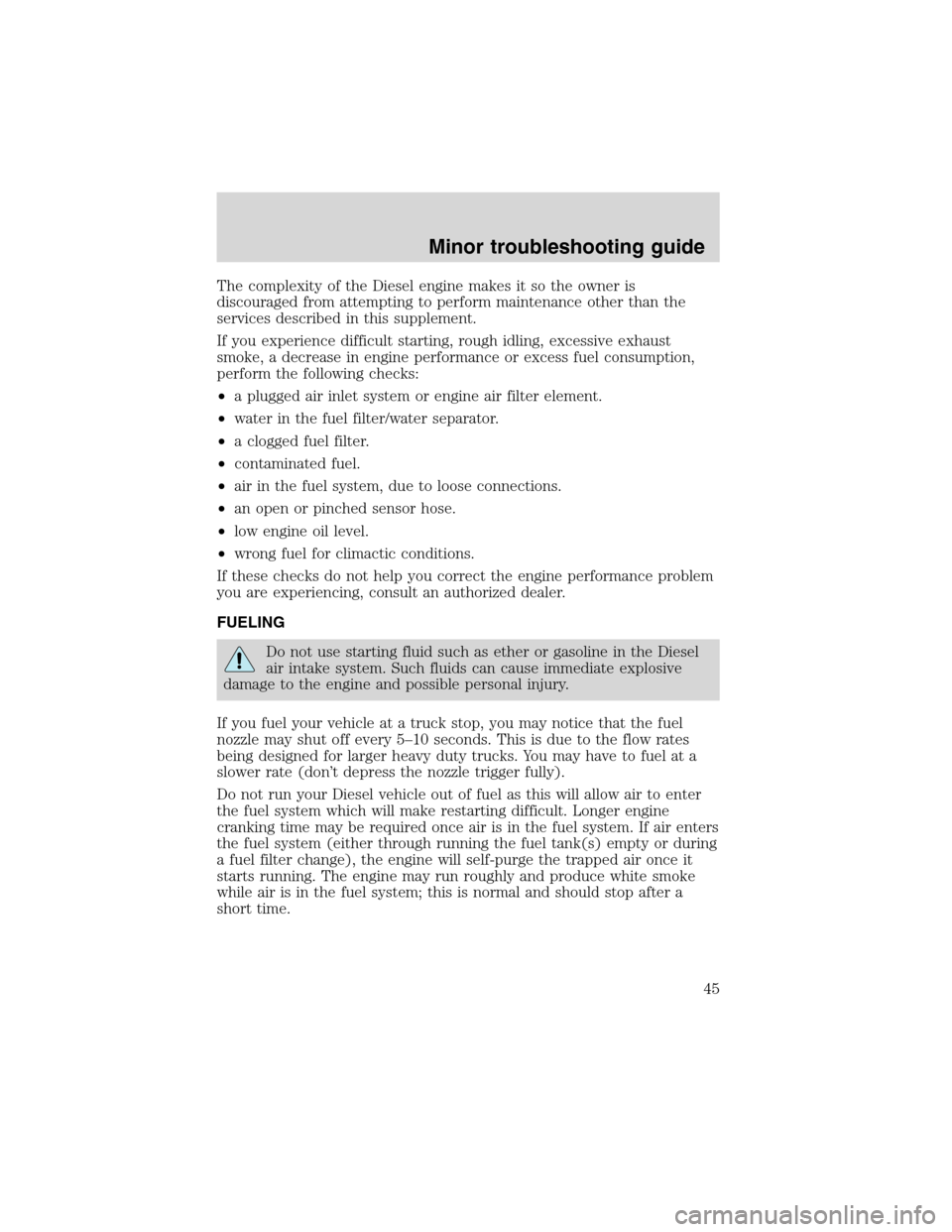Page 4 of 56

DIESEL ENGINE INFORMATION
The Diesel engine fuel system consists of:
•a frame-mounted electric fuel supply pump
•an engine mounted fuel filter/water separator
•a fuel restriction sensor
•a unit injector for each cylinder
The combination fuel filter/water separator removes both water and
impurities from the fuel. The filter should be changed at the
recommended service interval. Refer to the scheduled maintenance guide
for more information. The filter bowl should be drained at regular
intervals or when the WATER IN FUEL light illuminates in the
instrument cluster.
The fuel injectors are located in the center of the combustion chambers
in the cylinder head between the rocker arm assemblies. The glow plug
system and fuel injection system are controlled through the Powertrain
Control Module (PCM).
Fuel is drawn from the fuel tank by a frame-mounted electric fuel pump.
The fuel pump provides pressurized fuel to the engine and is
electronically controlled by the fuel pump PCM relay. The fuel pump
contains a pressure relief valve for overpressure protection in the event
of restricted flow.
Lubrication system
It is important to change the engine oil at the recommended service
intervals, because oil viscosity is important in maintaining the oil
pressure required to actuate the fuel injectors. Extended oil change
intervals can negatively affect engine performance and fuel economy.
Pressurized oil from the turbocharger is also used to actuate an exhaust
backpressure warm-up system (if equipped). Pressurized oil from the
turbocharger is routed to the exhaust backpressure actuator. During
exhaust backpressure operation, the engine’s sound will be altered and
you may notice a change in engine performance while it’s engaged. This
function occurs only during cold weather warm-up cycle.
Fast start glow plug system
The glow plug system consists of:
•eight glow plugs
•the glow plug relay
Diesel information
4
Page 5 of 56

•engine oil temperature (EOT) sensor
•barometric pressure (BARO) sensor
The glow plug system is electronically controlled by the PCM. The PCM
energizes the glow plugs immediately after the ignition is placed in the
ON position, then determines how long the glow plugs will be on
according to the EOT and BARO sensors. The required time for the glow
plugs to be energized decreases as the engine oil temperature and
barometric pressure increase.
Engine cooling system
The cooling system contains an engine oil cooler which is mounted to
the side of the cylinder block. The cooler’s function is to regulate engine
oil temperature.
Engine governed speed
The engine governor is controlled by the PCM. The PCM controls fuel
input to limit maximum engine speed. It will not, however, prevent
engine overspeeding resulting from downshifting at high vehicle speed or
by descending steep grades at too high a vehicle speed for the selected
transmission gear.
For maximum vehicle speed in various gears, refer toManual
transmission shift speedsin theDriving tipschapter. Do not exceed
3,600 rpm. Maximum engine governed speed is 3,000–4,000 rpm
depending on engine load. Excessive rpm can only be achieved by
manually downshifting at too high of a vehicle speed.
Operating the engine beyond the governed speed can cause severe
engine damage.
Air filter restriction gauge, E-Series
The restriction gauge, located on
the clean-air side of the air cleaner
upper housing, shows if the air filter
is clogged. Refer toEngine
CompartmentinService points
chapter.
AIRFILTERGAUGECHANGEFILTERCHANGEFILTER
Diesel information
5
Page 45 of 56

The complexity of the Diesel engine makes it so the owner is
discouraged from attempting to perform maintenance other than the
services described in this supplement.
If you experience difficult starting, rough idling, excessive exhaust
smoke, a decrease in engine performance or excess fuel consumption,
perform the following checks:
•a plugged air inlet system or engine air filter element.
•water in the fuel filter/water separator.
•a clogged fuel filter.
•contaminated fuel.
•air in the fuel system, due to loose connections.
•an open or pinched sensor hose.
•low engine oil level.
•wrong fuel for climactic conditions.
If these checks do not help you correct the engine performance problem
you are experiencing, consult an authorized dealer.
FUELING
Do not use starting fluid such as ether or gasoline in the Diesel
air intake system. Such fluids can cause immediate explosive
damage to the engine and possible personal injury.
If you fuel your vehicle at a truck stop, you may notice that the fuel
nozzle may shut off every 5–10 seconds. This is due to the flow rates
being designed for larger heavy duty trucks. You may have to fuel at a
slower rate (don’t depress the nozzle trigger fully).
Do not run your Diesel vehicle out of fuel as this will allow air to enter
the fuel system which will make restarting difficult. Longer engine
cranking time may be required once air is in the fuel system. If air enters
the fuel system (either through running the fuel tank(s) empty or during
a fuel filter change), the engine will self-purge the trapped air once it
starts running. The engine may run roughly and produce white smoke
while air is in the fuel system; this is normal and should stop after a
short time.
Minor troubleshooting guide
45